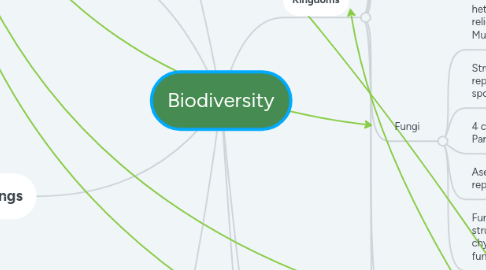
1. Domains
1.1. Archaea (very primitive form of bacteria). Includes kingdom Archaebacteria
1.2. Eukarya (all life forms with eukaryotic cells). Includes kingdoms protista, animalia, plantae and fungi
1.3. Bacteria (more advanced form of bacteria). Includes kingdom Eubacteria
2. Types of cells
2.1. Prokaryotic: Unicellular, simple, small, few organelles, usually reproduce asexually (ex: bacteria and archea)
2.2. Eukaryotic: Multicellular, large, complex, have a flagella, many organelles, membrane-bound nucleus (ex: plants and animals)
2.3. Endosymbiosis theory: Prokaryotes were the only organisms on earth at first. Then, they engulfed each other and became eukaryotes via a symbiotic relationship.
2.3.1. Proof of the theory: Circular DNA and ribosomes, reproduce similarly, inner membrane, same composition
3. Characteristics of living things
3.1. 1. Composed of cells
3.2. 2. Different levels of organization (tissue, organs, organ systems)
3.3. 3. Use energy for maintenance and growth
3.4. 4. Respond to their environment
3.5. 5. Grow
3.6. 6. Reproduce
3.7. 7. Adaptable to their environment
4. Viruses
4.1. They are non-living, have genetic material (either DNA or RNA), can reproduce quickly and takes over a host (can't live on it's own).
4.2. Lyctic cycle
4.2.1. 1. Attachement: Virus attaches to host cell
4.2.2. 2. Insertion: Virus DNA enters cell
4.2.3. 3. Replication. Cell DNA is destroyed and new viral DNA is produced
4.2.4. 4. Assembly. Viruses made inside host cell using DNA in step 3
4.2.5. 5. Lysis. Cell breaks open and virus is released
4.3. Lysogenic cycle (our body cannot recognize the virus because there is no lysis, until the trigger).
4.3.1. 1. Virus attaches to host cell
4.3.2. 2. Virus DNA enters cell
4.3.3. 3. Virus DNA mixes with cell DNA
4.3.4. 4. Cell continues to replicate viral DNA on it's own until triggered by environment change
4.4. Structure: Capsid is the outer layering securing DNA and tail fibre is helping secure the virus on the host
5. Kingdoms
5.1. Bacteria
5.1.1. Found everywhere on Earth except extreme environments.
5.1.2. Unicellular, prokaryotic, some autotrophic, some heterotrophic, cell wall made of peptidoglycan
5.1.2.1. General shapes: Cocci (round), bacilli (rod), spirilli (spiral), vibrio (comma)
5.1.2.2. Growth patterns/groupings: Diplo (arranged in pairs), staphylo (clusters), strepto (chains)
5.1.2.3. Naming bacteria: Grouping-shape
5.1.3. Cell wall structure: Gram positive and negative (thick or thin protein layer and different colour stains)
5.2. Animalia
5.2.1. Multicellular, eukaryotic, heterotrophic, live in diverse environments
5.3. Archea
5.3.1. Unicellular, prokaryotic, some autotrophic, some heterotrophic, different from bacteria in the chemical structure/makeup of cells.
5.3.2. Known as the more ancient form of bacteria. Thrive in the most extreme environments such as thermal vents, hot springs, salt water, swamps, cow intestines.
5.3.2.1. Mathanogens (methane-producing archaea), halophiles (salt-loving), thermoacidophiles (heat and acid-loving)
5.4. Fungi
5.4.1. Eukaryotic, multicellular mostly, heterotrophic, cell wall made of chitin, relies on decaying matter for food. ex: Mushrooms, yeast, mold
5.4.2. Structure: Fruiting body = above ground, reproductive structure, produces airborne spores in favorable conditions
5.4.2.1. Mycelium = below ground, bulk of organism, net-like mass made of branching hyphae
5.4.2.1.1. Hyphae = Basic structural unit, thread like filament
5.4.3. 4 categories of fungi based on nutrition: Parasitic, predatory, mutualistic, saprobial
5.4.4. Asexual reproduction types: Spore reproduction, budding and fragmentation
5.4.5. Fungal classification (based on structure/reproduction): Fungi imperfecti, chytrids, zygospore fungi, sac fungi, club fungi
5.5. Plantae
5.5.1. Cell wall made of cellulose, multicellular, eukaryotic, autotrophic (uses photosynthesis), mostly live on land
5.6. Protista
5.6.1. Odd organisms that are not classified elsewhere, likes marine environments (ex: paramecium, amoeba)
5.6.2. Eukaryotic, most unicellular, some have cell wall
6. Hierarchy used for taxonomy
6.1. 1. Domain (ex: Eukarya)
6.2. 2. Kingdom (ex: Animalia)
6.3. 3. Phylum (ex: Chordata)
6.4. 4. Class (ex: Mammalia)
6.5. 5. Order (ex: Carnivora)
6.6. 6. Family (ex: Canidae)
6.7. 7. Genus (ex: Canis)
6.8. 8. Species (ex: lupus)
6.8.1. Species can be classified by 3 species concepts:
6.8.1.1. Biological species concept (ability to interbreed)
6.8.1.2. Morphological species concept (structure)
6.8.1.3. Phylogenetic species concept (common ancestors)
